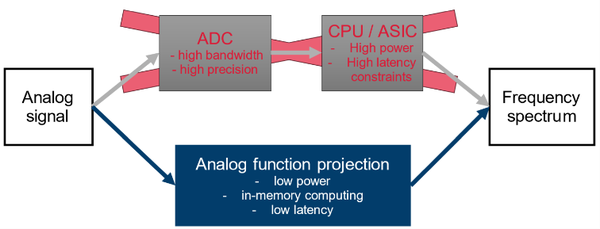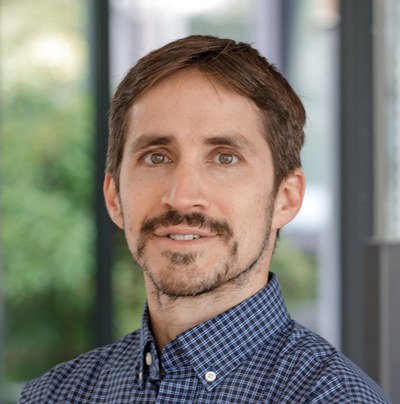High-speed Analogue Data Processing for Real-time Projection in High-dimensional Function Space
TO-144 • PT 1.3087 • As of 03/2024
Peter Grünberg Institute
Theoretical Nanoelectronics (PGI-14)
Technology
Our new technology involves a method and device for data processing, allowing for the continuous-time multiplication of an analogue electrical input signal with a matrix. This enables the projection of the input signal into a high-dimensional function space in a continuous-time manner, especially in real-time. Compared to digital data processing, this approach offers significantly increased speed and reduces energy consumption by performing vector matrix multiplications in an in-memory compute fashion, avoiding extensive data transfers.
Problem addressed
Data processing, involving analogue-to-digital conversion and algorithm execution in either application-specific integrated circuits (ASICs) in or conventional computer systems, faces challenges such as high energy consumption, large chip area requirements, and limited flexibility. Universal processors offer versatility but at the cost of increased resources. This leads to significant time delays and high energy consumption, especially with General Purpose Processors (CPPs). ASICs, while efficient, lack flexibility. An example application is the generation of a frequency spectrum of the input signal. The classical digital implementation requires costly analogue-to-digital conversion with high bandwidth and accuracy. There is thus the need to consider these drawbacks and explore alternatives that offer a balance between efficiency and flexibility to optimise data processing tasks.

Solution
The advantages of our new approach lie in its ability to process analogue signals in real-time, without the need for discretisation and analogue-to-digital conversion. The use of crossbar matrices allows for efficient multiplication and projection of input signals into function spaces in a single processing step. This results in faster processing speeds and the ability to handle complex data transformations, such as Fourier projections, with ease. The resistive matrix implementation further enhances the efficiency and accuracy of the processing, making it suitable for various applications. The Peter-Grünberg-Institute is advancing the development of memristive switching technologies. The realisation of the resistive matrix with these emerging memory devices allows to change the matrix at runtime and thereby realise different algorithms in the same device even by the end-user.
Benefits and Potential Use
Our new technology can be applied in various fields, such as automatic speech processing using features in the frequency spectrum such as Mel Frequency Cepstrum Coefficients (MFCCs), pattern recognition for event detection, and predictive maintenance in technical systems. It can handle both one-dimensional signals like audio and multi-dimensional signals like video, offering continuous processing for each pixel or element. By projecting input signals into higher-dimensional spaces, it enables the detection of patterns and events that may indicate the need for maintenance or other actions. The ability to compress and transmit data efficiently makes it suitable for applications requiring bandwidth reduction, such as in communication systems. Overall, the technology offers a versatile and efficient solution for real-time analogue data processing in diverse applications.
Development Status and Next Steps
Forschungszentrum Jülich has extensive expertise in this field and holds several patents. The technology described above is continuously being developed further. The Peter Grünberg Institute (PGI-14) – Neuromorphic Compute Nodes – already cooperates with numerous national and international companies and scientific partners. Forschungszentrum Jülich focuses on energy and cost-efficient devices, suitable for various emerging technologies. We are continuously seeking for cooperation partners and/or licensees in this and adjacent areas of research and applications.
TRL
2
IP
DE102024201676.4
Further patent filing is being pursued.
Keywords
Analogue data processing, ASICs, Matrix Operations, High-dimensional function space, Real-time projection, Fourier polynomials
Contact us
Prof Dr John Paul Strachan
Head of Institute
- Peter Grünberg Institute (PGI)
- Neuromorphic Compute Nodes (PGI-14)
Building TZA-Aachen /
Room C3.13
Room C3.13
+49 241/92-780421
E-Mail
More technologies
Last Modified: 02.06.2025


